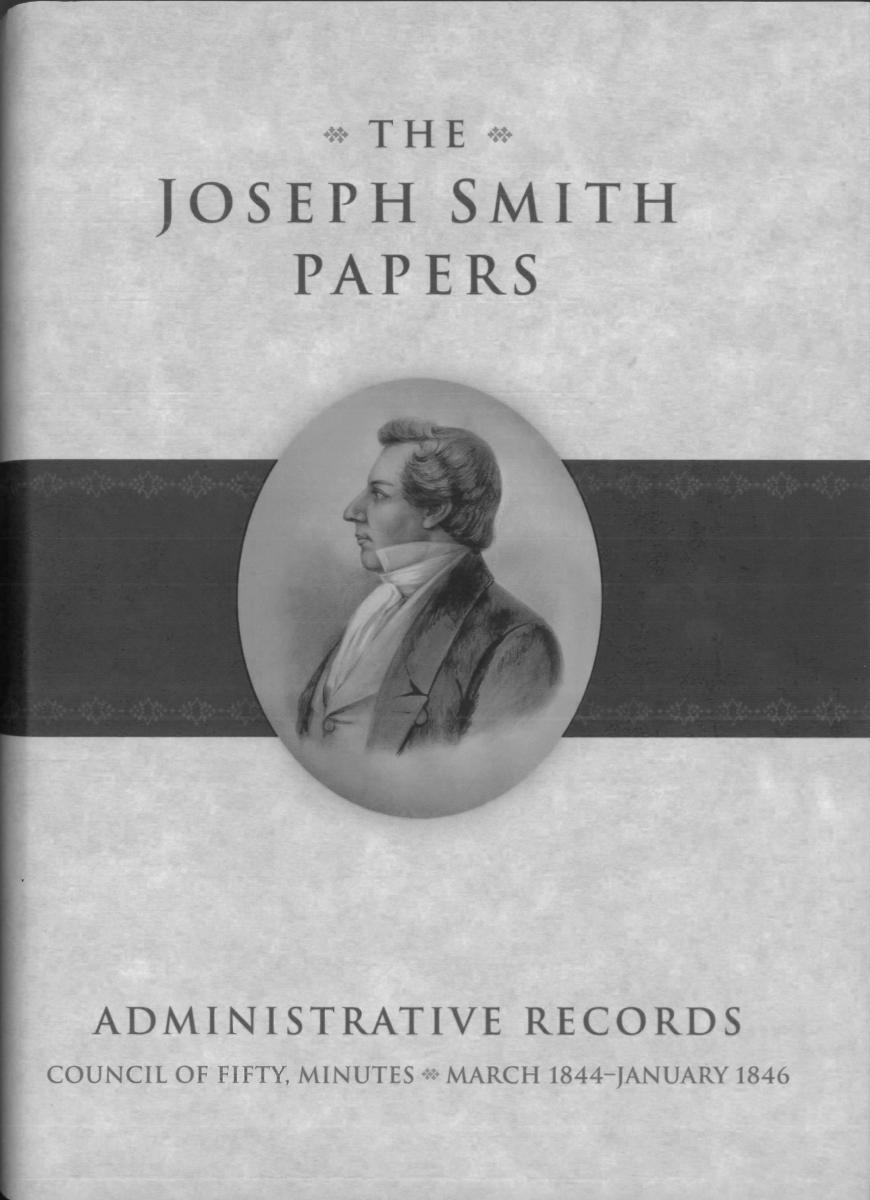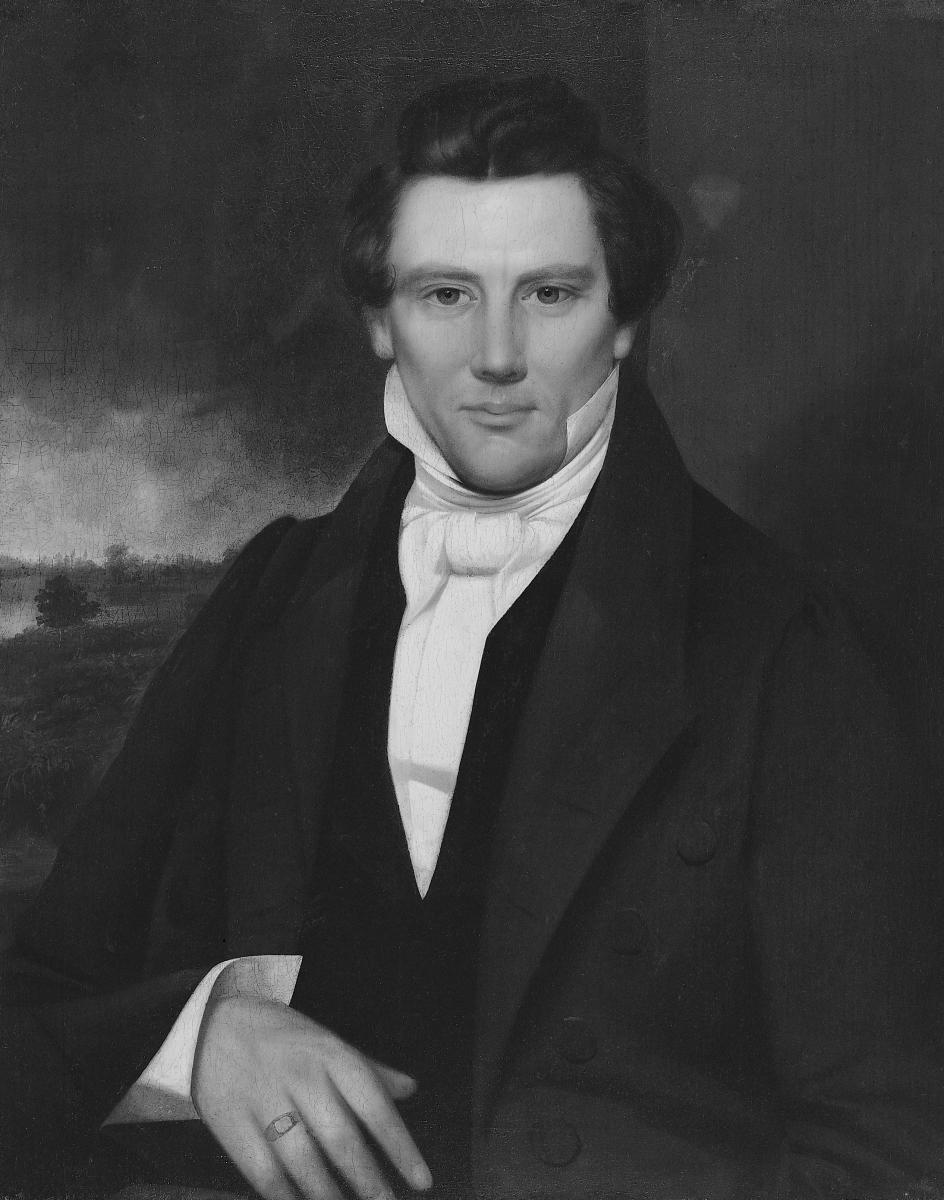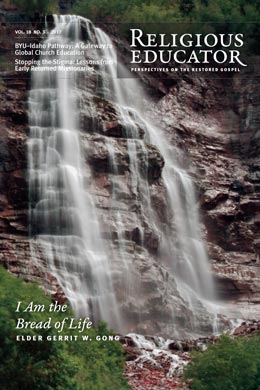Review of Council of Fifty, Minutes, March 1844–1846, Volume 1 of the Administrative Records Series of The Joseph Smith Papers
Benjamin E. Park
Benjamin E. Park, "Review of Council of Fifty, Minutes, March 1844–1846," Religious Educator 18, no. 3 (2018): 183–87.
Benjamin E. Park (bpark@shsu.edu) was an assistant professor of history at Sam Houston State University when this was written.
 Matthew J. Grow, Ronald K. Esplin, Mark Ashurst-McGee, Gerrit J. Dirkmaat, and Jeffrey D. Mahas, eds. Council of Fifty, Minutes, March 1844–January 1846. Vol. 1 of the Administrative Records series of The Joseph Smith Papers, ed. Ronald K. Esplin, Matthew J. Grow, and Matthew C. Godfrey. Salt Lake City: Church Historian’s Press, 2016.
Matthew J. Grow, Ronald K. Esplin, Mark Ashurst-McGee, Gerrit J. Dirkmaat, and Jeffrey D. Mahas, eds. Council of Fifty, Minutes, March 1844–January 1846. Vol. 1 of the Administrative Records series of The Joseph Smith Papers, ed. Ronald K. Esplin, Matthew J. Grow, and Matthew C. Godfrey. Salt Lake City: Church Historian’s Press, 2016.
The Council of Fifty, a clandestine organization founded by Joseph Smith in the final months of his life, has remained one of the most controversial episodes in LDS history. Created during Smith’s 1844 presidential run and while internal and external tensions in Nauvoo were reaching a boiling point, the council embodied both the Church’s growing anxiety and its desperate attempts to find some path to resolution. And because the written records of the council have been restricted from scholars since their origin, the many historians who have tried to reconstruct these meetings were forced to do the equivalent of seeing a picture through its negative: tracing all the contours, purposes, and activities simply through outlining everything taking place around it. But despite these valiant efforts, there remained a poignant hole at the center of Nauvoo’s history.
With the publication of the Council of Fifty minutes as the sole volume in the Joseph Smith Papers’s Administrative Records series, that hole can now be filled. These are richly detailed notes from two years’ worth of meetings that took place between March 1844 and January 1846. They were written by William Clayton, the council’s secretary, who took loose notes at the moment and then copied them into three small minute books. He was instructed to destroy the original records, but the books remained in Church possession ever since. The minute books were handed over to the Joseph Smith Papers Project a few years ago as reference tools for their work on Nauvoo-related volumes, and they soon received permission to publish the entirety of the Nauvoo records. The very existence of this volume is a testament to the Church’s commitment to historical transparency.
The immediate prompt for the council’s organization in early March 1844 was a report from several Saints living outside of Nauvoo of potential new settlement opportunities in the Southwest. As problems with their Illinois neighbors continued to grow, it made sense to look elsewhere for further expansion, and Texas seemed a promising option. This news came on the heels of Smith publicly announcing his run for the White House and when an earnest effort to send electioneering missionaries across the nation was underway. The Church’s leadership was busy. It was logical, then, to create a new council that could oversee these activities, both public and private, in a pattern that matched Smith’s consistent desire to correlate developments through governing bodies. This was not to be a simple rubber-stamp assembly either: Smith urged that “he did not want to be forever surrounded by a set of doughheads” (39). Participants were sworn to secrecy, and the group met nearly weekly for the rest of Smith’s life.
Discussions, which were structured to hear from the oldest down to the youngest, revolved around political questions. Disillusioned with America’s democratic system, they imagined alternate forms of sovereignty. “All seemed agreed,” noted minutes from the first meeting, on 11 March, “to look to some place where we can go and establish a Theocracy either in Texas or Oregon or somewhere in California &c” (40). They believed their council, organized “after the pattern of heaven” (43), was a prototype for world governance during the Millennium. This new political structure was based on several crucial elements. First, since modern secular governments overlooked the divine origin of laws, God’s authority would reign supreme. And second, building off of the Church’s mistreatment in Missouri and Illinois, the government had to preserve the rights and liberties of all religious minorities. The council even appointed a committee to draft a new constitution that was related to but diverged from America’s model. The resulting document, presented at the 18 April meeting, fit into a larger tradition of alternate constitutions drafted by marginal and outcast players in America’s political body. Yet even that was not enough, as Smith received a revelation a week later that declared the entire council was “my constitution” (137). God’s governance was too sacred and living to be reduced to text.
Though the council focused on overseeing federal petitions and political machinations in the spring and summer of 1844, Smith’s martyrdom proved a turning point. The council members took a six-month break following their president’s death in June and did not convene again until January 1845. Once reassembled, Brigham Young used the council to centralize his authority and coordinate the Church’s defense against external accusations. The tone of the meetings also became more ominous. Smith had allowed three non-Mormons into the council as a testament to his nonsectarian commitment, but Young dismissed them and reaffirmed ecclesiastical loyalty. In many ways, the “Lion of the Lord” tested his roaring voice within the meetings of the council. Many had given up hope that America’s democratic system could save them. As participants condemned the state and federal governments for failing to protect the adherents of the Mormon faith, discussions often became unwieldy. Clayton complained at an earlier meeting that “in consequence of so much disorder and confusion,” with “three or four members . . . speaking at the same time,” the “minutes could not be taken in full” (169).
 The Council of Fifty was founded by Joseph Smith in the final months of his life, during his 1844 presidential run and when internal and external tensions in Nauvoo were reaching a boiling point.
The Council of Fifty was founded by Joseph Smith in the final months of his life, during his 1844 presidential run and when internal and external tensions in Nauvoo were reaching a boiling point.
Most of the council meetings throughout 1845 and the first month of 1846 were dedicated to organizing the coming exodus west. Members explored possible alliances with indigenous tribes, enticing correspondence with Texas officials, and geopolitical developments in the Northwest. During the summer, most of the focus was on either the Southwest, particularly Texas, or the Oregon Territory. Yet American attention on those regions eventually turned Mormon sights to Mexico, as war broke out in 1846. California was the council’s first desire, as access to the Pacific trade and the scarcity of European residents made it a tantalizing option. But by the fall the Saints had turned their attention to the Rocky Mountains, an interest that would never subside. These minutes fill in many gaps of our understanding of the Saints’ planning for their trek, as we see significant discussion concerning their attempts to organize an entire city for westward mobilization.
Put simply, the story of Nauvoo can no longer be told without a deep familiarity with the Council of Fifty minutes. These records provide a firsthand account of a religious community that felt under siege, as their rhetoric and actions became increasingly radical. Though there are plenty of portions that might seem scandalous when used as proof texts, together they tell a story fit for a modern drama.
Religious educators will find plenty of material for both personal and classroom use. Perhaps most importantly, and perhaps most surprisingly given this was Joseph Smith’s council, these minutes include a crucial view of a broad range of ideas. Following Smith’s original counsel to embrace dialogue and debate, readers will be introduced to competing visions for the Church’s future. For example, the day that council members received a first draft of the council’s new constitution, the afternoon’s meeting was devoted to debating crucial questions regarding the separation of church and state (118–29).[1] In the 1845 portion, there’s a debate over whether British or American governments provided a better model of liberty (265–68). Throughout, differing opinions concerning the nature and limits of religious liberty are also a constant feature. These minutes provide a vantage point to find ideological diversity nearly unmatched during the Nauvoo period. Assigning portions of the minutes to students will cast early LDS history in a very different light.
While there were no major “surprises” or “grenades” within these minutes, there was plenty to make the Nauvoo period come alive. Furthermore, the expert work by the Joseph Smith Papers team provided helpful introductions, exhaustive footnotes, and useful images and graphs throughout the volume. With all these resources available, it is nearly impossible for the reader to come away confused. In a historiographical field filled with documentary histories, it is difficult to determine a “classic” that stands out from the others. Yet Council of Fifty, Minutes, March 1844–January 1846 fits that bill. The LDS community would do well to study its contents and learn its lessons.
Notes
[1] See Benjamin E. Park, “The Council of Fifty and the Perils of Democratic Governance,” in The Council of Fifty: What the Records Reveal about Mormon History, ed. Matthew J. Grow and R. Eric Smith (Provo, UT: Religious Studies Center, 2017).
